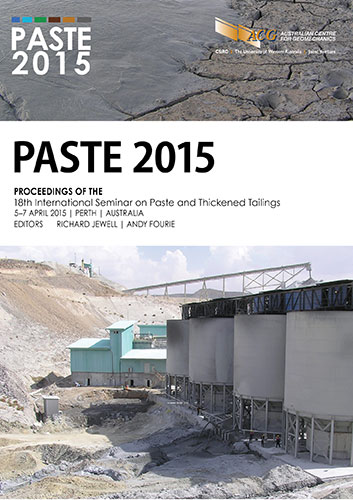Assessing the flow liquefaction susceptibility of cyclone underflow material

|
Authors: Boshoff, J; Reid, D; Utting, L |
DOI https://doi.org/10.36487/ACG_rep/1504_33_Boshoff
Cite As:
Boshoff, J, Reid, D & Utting, L 2015, 'Assessing the flow liquefaction susceptibility of cyclone underflow material', in R Jewell & AB Fourie (eds), Paste 2015: Proceedings of the 18th International Seminar on Paste and Thickened Tailings, Australian Centre for Geomechanics, Perth, pp. 433-440, https://doi.org/10.36487/ACG_rep/1504_33_Boshoff
Abstract:
It has been recognised worldwide that the liquefaction risk of unconstrained tailings stacks or cyclone underflow embankments requires careful consideration. The stability of a tailings deposit where the perimeter embankments are made up of hydraulic fill is often governed by post-liquefaction stability. Apart from Australia, cyclones are frequently used in different parts of the world to classify tailings into a coarse underflow, for building a tailings impoundment wall, and a finer fraction that is disposed of into the basin. The shear strength of the tailings forming the outer embankment of a tailings storage facility and the location of the phreatic surface are the two most significant factors influencing the structural integrity of the facility. The coarse underflow is placed in such a way as to contain the overflow, which is finer, has low strength, and is often poorly consolidated. Golder Associates Pty Ltd undertook a cyclone field trial at a gold mine site in Western Australia to assess the feasibility of using the cyclone deposition method to optimise and increase the capacity of an existing tailings cell. The aim of the cyclone trial was to collect information to demonstrate to the client and the regulators that cyclone deposition was a feasible option for raising TSF embankments. The cyclone trial provided an opportunity to assess the cyclone under field conditions and to assess the quantity and quality of the underflow fraction produced on site. A variety of methods were used to assess the flow liquefaction susceptibility of the tailings underflow sample produced during the cyclone field trial. The field trial, laboratory testing and analysis will be discussed in this paper.
References:
Atkinson, JH & Lau, WHW 1991, ‘Measurement of soil strength in simple shear tests’, Canadian Geotechnical Journal, vol. 28, no. 2, pp. 255-262.
Bedin, J, Schnaid, F, Da Fonseca, AVD & Costa Filho, LDM 2012, ‘Gold tailings liquefaction under critical state soil mechanics’, Géotechnique, vol. 62, no. 3, pp. 263-267.
Fourie, AB & Papageorgiou, G 2001, ‘Defining an appropriate steady state line for Merriespruit gold tailings’, Canadian Geotechnical Journal, vol. 38, no. 4, pp. 695-706.
Fourie, AB & Tshabalala, L 2005, ‘Initiation of static liquefaction and the role of K0 consolidation’, Canadian Geotechnical Journal, vol. 42, no. 3, pp. 892-906.
Jefferies, M & Been, K 2006, Soil liquefaction – a critical state approach, Taylor & Francis, Abingdon.
McPhail, G, Noble, A, Papageorgiou, G & Wilkinson, D 2004, ‘Development and implementation of thickened tailings discharge at Osborne Mine, Queensland, Australia’, Proceedings of the International Seminar on Paste and Thickened Tailings, Australian Centre for Geomechanics, Perth.
Sheeran, DE & Krizek, RJ 1971, ‘Preparation of homogenous soils samples by slurry consolidation’, Journal of Materials ASTM, vol. 6, no. 2, pp. 356-373.
Wates, JA, Venter, H, O’Callaghan, A & Tucker, J 2014, ‘The influence of feed properties on cyclone performance and stacking of underflow’, in RJ Jewell, AB Fourie, PS Wells & D van Zyl (eds), Proceedings of the 17th International Seminar on Paste and Thickened Tailings, InfoMine, Inc., Vancouver, pp. 445-458.
© Copyright 2024, Australian Centre for Geomechanics (ACG), The University of Western Australia. All rights reserved.
View copyright/legal information
Please direct any queries or error reports to repository-acg@uwa.edu.au
View copyright/legal information
Please direct any queries or error reports to repository-acg@uwa.edu.au